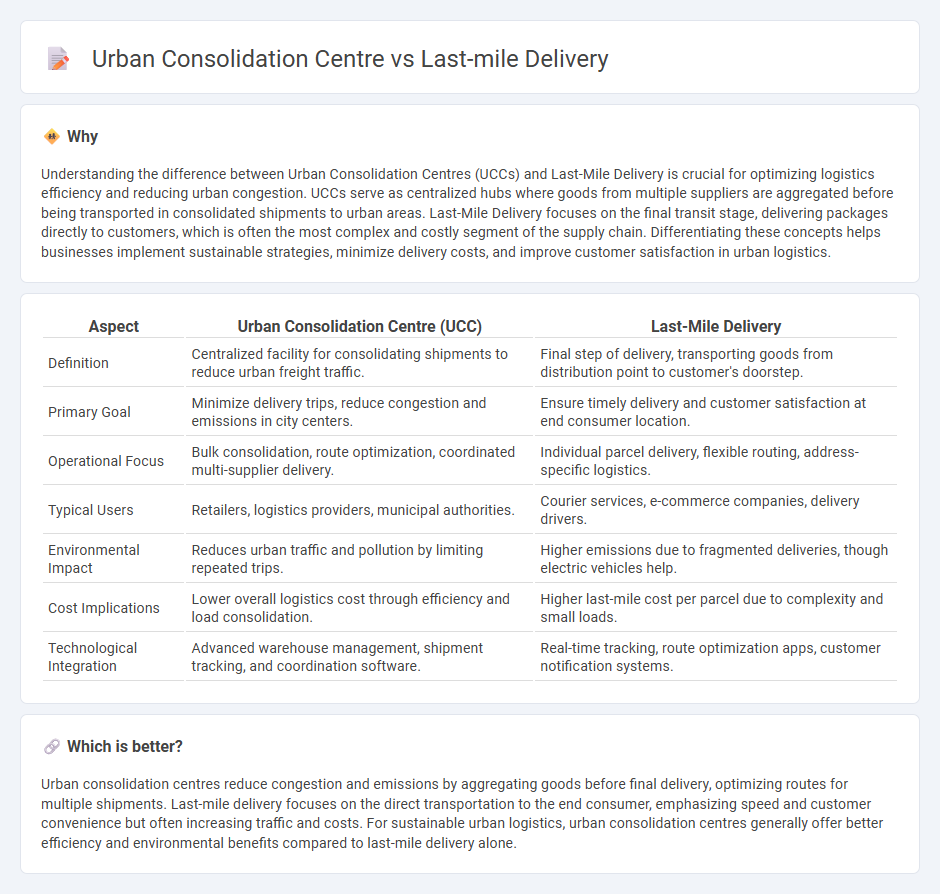
Urban consolidation centres reduce delivery traffic and emissions by centralizing shipments before final distribution, optimizing routes and load capacities. Last-mile delivery focuses on the final transport leg to customers, often facing challenges like congestion, high costs, and environmental impact in urban areas. Explore how these logistics strategies transform city deliveries and enhance sustainability.
Why it is important
Understanding the difference between Urban Consolidation Centres (UCCs) and Last-Mile Delivery is crucial for optimizing logistics efficiency and reducing urban congestion. UCCs serve as centralized hubs where goods from multiple suppliers are aggregated before being transported in consolidated shipments to urban areas. Last-Mile Delivery focuses on the final transit stage, delivering packages directly to customers, which is often the most complex and costly segment of the supply chain. Differentiating these concepts helps businesses implement sustainable strategies, minimize delivery costs, and improve customer satisfaction in urban logistics.
Comparison Table
| Aspect | Urban Consolidation Centre (UCC) | Last-Mile Delivery |
|---|---|---|
| Definition | Centralized facility for consolidating shipments to reduce urban freight traffic. | Final step of delivery, transporting goods from distribution point to customer's doorstep. |
| Primary Goal | Minimize delivery trips, reduce congestion and emissions in city centers. | Ensure timely delivery and customer satisfaction at end consumer location. |
| Operational Focus | Bulk consolidation, route optimization, coordinated multi-supplier delivery. | Individual parcel delivery, flexible routing, address-specific logistics. |
| Typical Users | Retailers, logistics providers, municipal authorities. | Courier services, e-commerce companies, delivery drivers. |
| Environmental Impact | Reduces urban traffic and pollution by limiting repeated trips. | Higher emissions due to fragmented deliveries, though electric vehicles help. |
| Cost Implications | Lower overall logistics cost through efficiency and load consolidation. | Higher last-mile cost per parcel due to complexity and small loads. |
| Technological Integration | Advanced warehouse management, shipment tracking, and coordination software. | Real-time tracking, route optimization apps, customer notification systems. |
Which is better?
Urban consolidation centres reduce congestion and emissions by aggregating goods before final delivery, optimizing routes for multiple shipments. Last-mile delivery focuses on the direct transportation to the end consumer, emphasizing speed and customer convenience but often increasing traffic and costs. For sustainable urban logistics, urban consolidation centres generally offer better efficiency and environmental benefits compared to last-mile delivery alone.
Connection
Urban consolidation centres serve as centralized hubs where goods from multiple suppliers are aggregated before being distributed to final destinations, significantly enhancing last-mile delivery efficiency. By reducing the number of delivery vehicles entering congested urban areas, these centres minimize traffic congestion, lower emissions, and improve delivery speed. Integrating urban consolidation centres with optimized last-mile delivery routes enables logistics companies to provide cost-effective, sustainable, and timely services to customers in dense metropolitan regions.
Key Terms
Last-mile delivery:
Last-mile delivery maximizes efficiency by directly transporting packages from distribution hubs to end customers, reducing transit times and increasing customer satisfaction in dense urban areas. It leverages technologies such as route optimization, real-time tracking, and electric vehicles to minimize costs and environmental impact. Explore effective last-mile delivery strategies to enhance your logistics and urban fulfillment operations.
Route optimization
Last-mile delivery faces significant challenges with traffic congestion and inefficient routing, leading to increased costs and carbon emissions. Urban consolidation centres optimize routes by centralizing deliveries and deploying eco-friendly vehicles for the final leg, reducing travel distances and enhancing delivery efficiency. Discover how integrating urban consolidation centres revolutionizes route optimization for sustainable last-mile delivery.
Customer proximity
Last-mile delivery directly impacts customer proximity by ensuring packages reach their final destination quickly, often at the consumer's doorstep, enhancing convenience and satisfaction. Urban consolidation centres optimize this process by centralizing deliveries and reducing congestion, allowing for more efficient and environmentally friendly distribution within dense city areas. Explore how integrating both strategies can revolutionize urban logistics and improve customer experience.
Source and External Links
Last mile delivery: solutions for your business | DHL Discover - Last-mile delivery is the final leg of a shipment from a local distribution center to the end consumer, aiming to deliver packages affordably, quickly, and accurately via vans, bikes, or drop-off points, with new trials including autonomous robots and drones.
Last Mile Delivery Logistics, Trends and Data for Retailers Explained - Last-mile delivery is the final phase when a product moves from a distribution center to customers, crucial for customer satisfaction but costly and time-consuming, with benefits including faster delivery, increased convenience, and higher sales.
What is Last Mile Delivery? Everything You Need to Know - Onfleet - Last mile delivery is the last step of moving a parcel from a transportation hub to its final destination and is critical for speed and efficiency in industries like e-commerce and retail, involving steps such as order digitization, sorting, and route planning.
 dowidth.com
dowidth.com